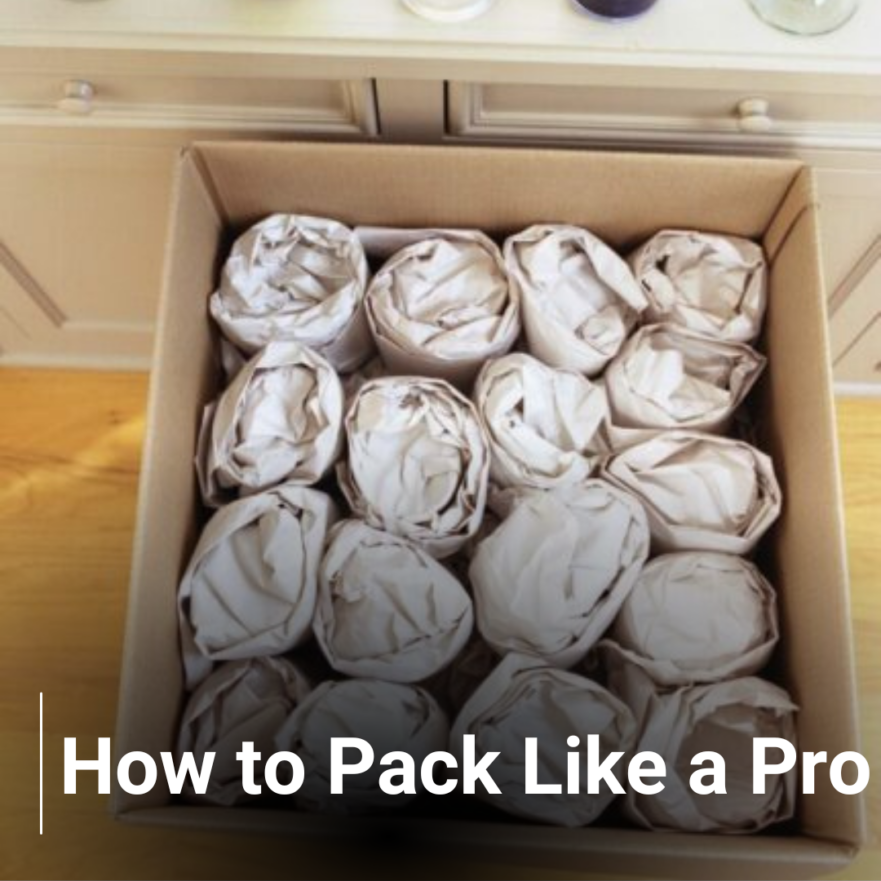Doing your own packing is a great way to get organized and save money on your move. Even if you plan to do the packing, there are some items that are best left for the movers to prepare. Large mirrors or pictures, glass tops, mattresses, and TVs are some of the items that you should consider having the movers pack for you. There are a lot of ins and outs to the moving process. Luckily, MiniMoves® can help you save money and successfully pack for moving.
Packing Tip #1
Solid cartons make all the difference. You can buy new mover-sized boxes at nearby moving companies like U-Haul and other truck rental locations or self-storage companies. We don’t recommend boxes from big box home repair stores. Although those boxes are great for storing things on a shelf, they are fragile and known to crush easily or tear open during a move. Mover’s boxes are of a higher quality and come in sizes that are designed to fit most household items. The boxes are versatile and can be stacked and loaded securely to better protect your goods.
You can also use older boxes if they are sturdy and can be taped closed. Small boxes are ideal for packing books, paper files, canned goods, and heavy tools. Medium boxes work best for moving and storing shoes, clothes, pots, pans, towels, and linens. Large boxes are the right choice for blankets, pillows, larger lamp shades and other big bulky items. Use double-wall “heavy-duty” boxes to pack glassware, lamps, breakable items, or heavy electronics. If you still have it, use the original packaging for your flat panel TV. Knowing what box to use is crucial to protecting your belongings and helping your move go smoothly.
Packing Tip #2
For a safe move, always make sure to have the top on your cartons. Fold the flaps together from opposite sides of the carton, ending with the last two flaps creating one seam across the carton. Use excellent quality carton tape to seal your boxes. The best way to tape your carton is across the seam and 1/2 way up the side of the box. The tape along the side of the box provides the strength to keep the carton closed and secure for transportation. A secure carton is essential and helps protect your goods as the movers carry boxes in and out of your home. Packing Tip #3
Labeling is crucial to keeping you and your items organized. The bonus is that clear marking helps you unpack faster, too! Every carton needs to have your name, MiniMoves® order number, and the room name on the top of the package. It’s always nice to help the moving crew with placing your belongings in the right room. Remember to make notes about the contents of the carton on the side of the box. An added bonus is that you will be able to read the information about the contents in the boxes before opening them after they are delivered and stacked in your new home. Help us, help you while also helping yourself- label your packages!
Packing Tip #3
Labeling is crucial to keeping you and your items organized. The bonus is that clear marking helps you unpack faster, too! Every carton needs to have your name, MiniMoves® order number, and the room name on the top of the package. It’s always nice to help the moving crew with placing your belongings in the right room. Remember to make notes about the contents of the carton on the side of the box. An added bonus is that you will be able to read the information about the contents in the boxes before opening them after they are delivered and stacked in your new home. Help us, help you while also helping yourself- label your packages!
Packing Tip #4
Don’t be shy- stuff your boxes. All boxes must be filled to the top to avoid being crushed during your move. First, put a good layer of cushioning in your box. Pack the box as full as you can and then fill any open spaces at the top with crushed newspaper or other cushioning before taping it shut. The box should close with slight pressure and the top of the carton should be flat and even. Cushioning and a solid box will help protect your belongings and make the move more secure.
Packing Tip #5
Be a pro and wrap fragile belongings the same way the experts do. Layering is key when packing valuable or fragile items. Use two or three layers of packing paper for each glass, dish, or figurine. Wrap firmly, but loose enough to provide a cushioning effect. You don’t want to put too much pressure on your items. At the same time, you also want them to be snug enough to absorb any shocks that might occur during your move. Unprinted newsprint helps to keep your glassware and plates clean while packing. Newsprint without ink also helps you from getting messy and absorbing the ink from a newspaper, too. Bubble wrap is also an effective cushion between plates and protects fragile items. Plus, who doesn’t like to pop and play with bubble wrap every once in a while? In short, don’t hesitate to fill your boxes and when packing fragile items make sure that they are snug and secure before sealing your container.
Packing Tip #6
The sequence of how you organize your box is key for a safe move. When working with dishware, pack glassware standing up and dishes on end. These items are much stronger and less likely to be damaged when packed on end. Wrap plates into bundles and be sure to layer two or three sheets of paper between each plate. Crumpled paper between layers provides cushioning. Bowls, saucers and serving plates are to be packed on their edges too. Follow these steps and you’ll be able to enjoy your post-move meal with your own dishware and utensils in no time.
Packing Tip #7
Avoid ironing! Wardrobe cartons save fabric from wrinkles and are equipped with a bar for hanging clothes or draperies. This box is the best way to pack items that require hangers. You will need one for every 24” of closet space. Wardrobe cartons are great for packing tall or unusually large items like silk plants and sports equipment.
Packing Tip #8
Stay organized and pack similar items together. Gather breakable items like glasses, mugs, plates, and bowls and put them into a dish pack. Dish packs are convenient. They are sturdy double-wall cartons that are designed to protect fragile items. Despite the name, dish packs protect more than dishes. They can be used for items like lamps. Two or more table lamp bases can be padded and placed in a dish pack too. Pack books and other durable items together. Pack clothes and other soft goods together. Remember to label your boxes! Marking your packages especially helps when you have related items in a box or container.
Packing Tip #9
We’re almost there! Plan ahead and anticipate the light at the end of the tunnel. Pack an “Open Me First” carton of things you are likely to need on the day you move into your home. Light bulbs, hand tools, paper towels, toilet paper, soap, trash bags, and a first aid kit are just some of the things that are good to have in one place on the day you move in. Make sure that the items you plan to need first are easily accessible. There’s nothing worse than having to move all your packages and containers to get to the first box that you need.
Packing Tip #10
Make sure you have all your stuff! Check your boxes at the time of delivery and make notes of the mover’s inventory and of any boxes that are torn, crushed, or missing. If you find damage in one of your boxes, you’ll need to stop unpacking and contact MiniMoves® so we can inspect the damage. MiniMoves® is here to help, so don’t hesitate to let us know if there is an issue.
Finally, kick back and relax! Your move is in good hands with MiniMoves®. Remember to pack like a pro and let us know if you have any questions or concerns. Make the best of moves with MiniMoves®!





